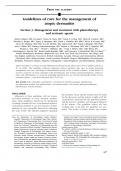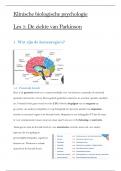FROM THE ACADEMY
Guidelines of care for the management of
atopic dermatitis
Section 3. Management and treatment with phototherapy
and systemic agents
Robert Sidbury, MD (Co-chair),a Dawn M. Davis, MD,b David E. Cohen, MD,c Kelly M. Cordoro, MD,d
Timothy G. Berger, MD,d James N. Bergman, MD,e Sarah L. Chamlin, MD, MSCI,f Kevin D. Cooper, MD,g
Steven R. Feldman, MD, PhD,h Jon M. Hanifin, MD,i Alfons Krol, MD,i David J. Margolis, MD, PhD,j
Amy S. Paller, MD,f Kathryn Schwarzenberger, MD,k Robert A. Silverman, MD,l Eric L. Simpson, MD,i
Wynnis L. Tom, MD,m,n Hywel C. Williams, DSc,o Craig A. Elmets, MD,p Julie Block, BA,q
Christopher G. Harrod, MS,r Wendy Smith Begolka, MBS,r and Lawrence F. Eichenfield, MD (Co-chair)m,n
Seattle, Washington; Rochester, Minnesota; New York, New York; San Francisco, San Diego, and
San Rafael, California; Vancouver, British Columbia, Canada; Chicago and Schaumburg, Illinois;
Cleveland, Ohio; Winston-Salem, North Carolina; Portland, Oregon; Philadelphia, Pennsylvania;
Memphis, Tennessee; Fairfax, Virginia; Nottingham, United Kingdom; and Birmingham, Alabama
Atopic dermatitis is a chronic, pruritic inflammatory dermatosis that affects up to 25% of children and 2% to
3% of adults. This guideline addresses important clinical questions that arise in atopic dermatitis
management and care, providing recommendations based on the available evidence. In this third of 4
sections, treatment of atopic dermatitis with phototherapy and systemic immunomodulators, antimicro-
bials, and antihistamines is reviewed, including indications for use and the risk-benefit profile of each
treatment option. ( J Am Acad Dermatol 2014;71:327-49.)
Key words: atopic dermatitis; azathioprine; cyclosporin A; interferon gamma; methotrexate;
mycophenolate mofetil; oral antihistamines; oral antimicrobials; oral steroids; photochemotherapy;
phototherapy; systemic therapy.
DISCLAIMER the propriety of any specific therapy must be made
Adherence to these guidelines will not ensure
by the physician and the patient in light of all the
successful treatment in every situation. Further-
circumstances presented by the individual patient,
more, these guidelines should not be interpreted
and the known variability and biological behavior
as setting a standard of care, or be deemed inclusive
of the disease. This guideline reflects the best
of all proper methods of care nor exclusive of other
available data at the time the guideline was pre-
methods of care reasonably directed to obtaining
pared. The results of future studies may require
the same results. The ultimate judgment regarding
From the Department of Dermatology, Seattle Children’s Hospital, San Diegon; Center of Evidence-based Dermatology,
Hospitala; Department of Dermatology, Mayo Clinic, Roches- Nottingham University Hospitals National Health Service Trusto;
terb; Department of Dermatology, New York University School Department of Dermatology, University of Alabama at Birming-
of Medicinec; Department of Dermatology, University of Cali- hamp; National Eczema Association, San Rafaelq; and American
fornia, San Franciscod; Department of Dermatology and Skin Academy of Dermatology, Schaumburg.r
Science, University of British Columbiae; Department of Derma- Funding sources: None.
tology, Northwestern University Feinberg School of Medicine, The authors’ conflicts of interest/disclosure statements appear at
Chicagof; Department of Dermatology, Case Western Univer- the end of the article.
sity, Clevelandg; Department of Dermatology, Wake Forest Accepted for publication March 17, 2014.
University Health Sciences, Winston-Salemh; Department of Reprint requests: Wendy Smith Begolka, MBS, American Academy
Dermatology, Oregon Health and Science Universityi; Depart- of Dermatology, 930 E Woodfield Rd, Schaumburg, IL 60173.
ment of Biostatistics and Epidemiology, University of Pennsyl- E-mail: wsmithbegolka@aad.org.
vania School of Medicinej; Kaplan-Amonette Department of Published online May 7, 2014.
Dermatology, University of Tennessee Health Science Centerk; 0190-9622/$36.00
private practice, Fairfaxl; University of San Diegom; Division of Ó 2014 by the American Academy of Dermatology, Inc.
Pediatric and Adolescent Dermatology, Rady Children’s http://dx.doi.org/10.1016/j.jaad.2014.03.030
327
,328 Sidbury et al J AM ACAD DERMATOL
AUGUST 2014
November 2003 through November 2012 for clinical
Abbreviations used:
questions addressed in the previous version of this
AAD: American Academy of Dermatology guideline published in 2004, and 1960 through 2012
AD: atopic dermatitis
AZA: azathioprine for all newly identified clinical questions as deter-
BB: broadband mined by the work group to be of importance to
CSA: cyclosporin A clinical care. Searches were prospectively limited to
FDA: Food and Drug Administration
GI: gastrointestinal publications in the English language. Medical Subject
HSV: herpes simplex virus Headings terms used in various combinations in the
IFN-G: interferon gamma literature search included: ‘‘atopic dermatitis,’’ ‘‘atopic
MMF: mycophenolate mofetil
MTX: methotrexate eczema,’’ ‘‘systemic agent(s),’’ ‘‘immunomodulatory,’’
NB: narrowband ‘‘immunosuppressive,’’ ‘‘cyclosporine,’’ ‘‘azathio-
PUVA: psoralen plus ultraviolet A prine,’’ ‘‘mycophenolate mofetil,’’ ‘‘methotrexate,’’
QOL: quality of life
SASSAD: Six Sign Six Area Atopic Dermatitis ‘‘interferon gamma,’’ ‘‘prednisone,’’ ‘‘prednisolone,’’
SCORAD: SCORing Atopic Dermatitis ‘‘biologics,’’ ‘‘TNF-alpha inhibitor,’’ ‘‘etanercept,’’ ‘‘in-
TPMT: thiopurine methyltransferase fliximab,’’ ‘‘leukotriene inhibitor,’’ ‘‘omalizumab,’’
UV: ultraviolet
‘‘oral tacrolimus,’’ ‘‘oral pimecrolimus,’’ ‘‘ascomycin,’’
‘‘thymopentin/TP-5,’’ ‘‘intravenous immunoglob-
ulin,’’ ‘‘theophylline,’’ ‘‘papaverine,’’ ‘‘phototherapy,’’
revisions to the recommendations in this guideline ‘‘photochemotherapy,’’ ‘‘ultraviolet,’’ ‘‘laser,’’ ‘‘sys-
to reflect new data. temic/oral antimicrobial,’’ ‘‘systemic/oral antibiotic,’’
‘‘antihistamines,’’ ‘‘cetirizine,’’ ‘‘fexofenadine,’’ ‘‘lora-
SCOPE tadine,’’ ‘‘terfenadine,’’ ‘‘olopatadine,’’ ‘‘clemastine,’’
This guideline addresses the treatment of pediat- ‘‘leukotriene,’’ ‘‘zafirlukast,’’ and ‘‘montelukast.’’
ric and adult atopic dermatitis (AD; atopic eczema) of A total of 1063 abstracts were initially assessed for
all severities, although systemic modalities are possible inclusion. After removal of duplicate data,
mainly recommended for moderate to severe 185 were retained for final review based on rele-
disease, or for patients whose dermatitis causes vancy and the highest level of available evidence for
significant psychosocial impact. The treatment of the outlined clinical questions. Evidence tables were
other forms of eczematous dermatitis is outside the generated for these studies and used by the work
scope of this document. Recommendations on AD group in developing recommendations. The
treatment and management are subdivided into 4 American Academy of Dermatology’s (AAD’s) prior
sections given the significant breadth of the topic, published guidelines on AD were evaluated, as were
and to update and expand on the clinical information other current published guidelines on AD.1,3-5
and recommendations previously published in The available evidence was evaluated using
2004.1 This document is the third of 4 publications a unified system called the Strength of
in the series and discusses the management of AD via Recommendation Taxonomy (SORT) developed by
phototherapy and systemic agents, including immu- editors of the US family medicine and primary care
nomodulators, antimicrobials, and antihistamines. journals (ie, American Family Physician, Family
Medicine, Journal of Family Practice, and BMJ
METHOD USA).6 Evidence was graded using a 3-point scale
A work group of recognized AD experts was based on the quality of methodology (eg, random-
convened to determine the audience and scope of ized control trial, case-control, prospective/
the guideline, and to identify important clinical retrospective cohort, case series) and the
questions in the use of phototherapy and systemic overall focus of the study (ie, diagnosis, treatment/
agents for the treatment of AD (Table I). Work prevention/screening, or prognosis) as follows:
group members completed a disclosure of interests I. Good-quality patient-oriented evidence (ie, evi-
that was updated and reviewed for potential dence measuring outcomes that matter to patients:
relevant conflicts of interest throughout guideline morbidity, mortality, symptom improvement,
development. If a potential conflict was noted, the cost reduction, and quality of life [QOL]).
work group member recused himself or herself from II. Limited-quality patient-oriented evidence.
discussion and drafting of recommendations III. Other evidence including consensus guidelines,
pertinent to the topic area of the disclosed interest. opinion, case studies, or disease-oriented evidence
An evidence-based model was used and evidence (ie, evidence measuring intermediate, physio-
was obtained using a search of the PubMed and the logic, or surrogate end points that may or may
Global Resources for Eczema Trials2 databases from not reflect improvements in patient outcomes).
, J AM ACAD DERMATOL Sidbury et al 329
VOLUME 71, NUMBER 2
Table I. Clinical questions used to structure Table II. Recommendations for the use of
the evidence review for the treatment of atopic phototherapy
dermatitis with phototherapy and systemic agents
Phototherapy is a second-line treatment, after failure of
d Which immunomodulatory agents are efficacious and first-line treatment (emollients, topical steroids, and
safe for the treatment of atopic dermatitis? topical calcineurin inhibitors).
n Cyclosporin A Phototherapy can be used as maintenance therapy in
n Azathioprine patients with chronic disease.
n Mycophenolate mofetil
n Methotrexate
Phototherapy treatment of all forms should be under the
n Interferon gamma
guidance and ongoing supervision of a physician
n Systemic steroids
knowledgeable in phototherapy techniques.
n Tumor necrosis factor-alpha inhibitors (etanercept, The light modality chosen should be guided by factors
infliximab)* such as availability, cost, patient skin type, skin cancer
n Leukotriene inhibitors history, and patient use of photosensitizing medications.
n Omalizumab*
The dosing and scheduling of light should be based on
n Oral calcineurin inhibitors
minimal erythema dose and/or Fitzpatrick skin type.
n Other (eg, thymopentin (TP)/TP-5, intravenous immu-
noglobulin, theophylline, papaverine) Home phototherapy under the direction of a physician
d What is the efficacy of systemic antimicrobials and may be considered for patients who are unable to
systemic antihistamines for the treatment of atopic receive phototherapy in an office setting.
dermatitis?
d What is the optimal dose, frequency of use, adverse immunoglobulin IgE levels and a personal or family
effects, and efficacy of phototherapy and photochemo- history of type I allergies, allergic rhinitis, and
therapy for the treatment of atopic dermatitis? asthma. Atopic eczema is synonymous with AD.
*Indicates new clinical questions.
INTRODUCTION
Despite its relapsing and remitting nature, the
Clinical recommendations were developed on the majority of patients with AD can achieve clinical
best available evidence tabled in the guideline. improvement and disease control with nonpharmaco-
These are ranked as follows: logic interventions (eg, emollient use), conventional
A. Recommendation based on consistent and good- topical therapies (including corticosteroids and calci-
quality patient-oriented evidence neurin inhibitors), and environmental and occupa-
B. Recommendation based on inconsistent or tional modifications, when necessary. Phototherapy is
limited-quality patient-oriented evidence. recommended as a treatment for both acute and
C. Recommendation based on consensus, opinion, chronic AD in children and adults, after failure of the
case studies, or disease-oriented evidence. measures mentioned above. Systemic immunomodu-
latory agents are indicated and recommended for the
In those situations where documented evidence- subset of adult and pediatric patients in whom
based data are not available, we have used expert optimized topical regimens using emollients, topical
opinion to generate our clinical recommendations. anti-inflammatory therapies, adjunctive methods,
This guideline has been developed in accordance and/or phototherapy do not adequately control the
with the AAD/AAD Association Administrative signs and symptoms of disease, and contact dermatitis
Regulations for Evidence-based Clinical Practice has been considered. Phototherapy and systemic
Guidelines (version approved May 2010), which immunomodulating agents may also be used in
includes the opportunity for review and comment patients whose medical, physical, and/or psycholog-
by the entire AAD membership and final review and ical states are greatly affected by their skin disease,
approval by the AAD Board of Directors.7 This which may include negative impact on work,
guideline will be considered current for a period of school performance, or interpersonal relationships.
5 years from the date of publication, unless reaf- Despite their frequent use in clinical practice, oral
firmed, updated, or retired at or before that time. antihistamines and systemic antimicrobials appear to
be of benefit only for specific circumstances (detailed
DEFINITION below), based on the scientific data to date.
AD is a chronic, pruritic inflammatory skin disease
that occurs most frequently in children, but PHOTOTHERAPY
also affects many adults. It follows a relapsing The use of light waves as a medical therapy
course. AD is often associated with elevated serum began in the 1890s. The most relevant use of





